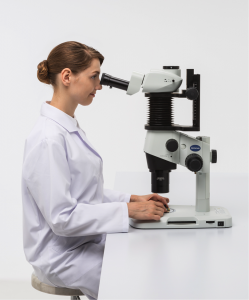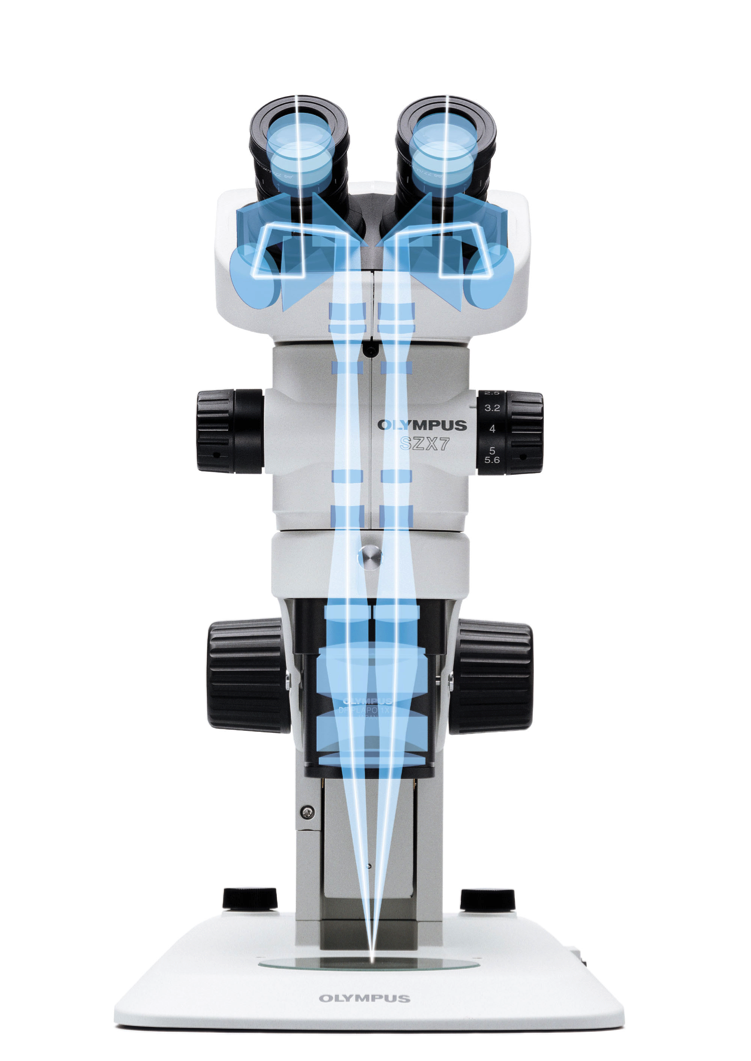In this interview, Megan Farell, Technical Sales Support Specialist from Olympus talks to AZoM about the role of ergonomics for industrial microscopy.
What is ergonomics and what value does it add to microscope users and the workplace?
Ergonomics is the science focused on the design and arrangement of items people use to improve efficiency and safety. Setting up microscopes and workstations with favorable ergonomics improves users' health and safety by preventing repetitive injuries and acute pain associated with strain, such as headaches. Proper ergonomics is especially important in routine microscopy, where operators examine samples under microscopes for at least half of the workday.
Taking ergonomics into consideration when arranging workspaces increases efficiency and productivity by minimizing strain and risk of injury on the operators. By preventing injuries and discomfort, microscope users can perform their jobs more effectively and avoid taking time off due to injury. Another benefit of proper ergonomics is an increase in employee morale due to the preservation of worker well-being and optimized working conditions.

What are the risk factors of poor ergonomics in the workplace?
One of the primary risk factors of poor ergonomics is work-related musculoskeletal disorders (MSDs). MSDs negatively impact muscles, nerves, blood vessels, ligaments, and tendons, including carpal tunnel syndrome, tendinitis, rotator cuff injuries, muscle strains, and low back injuries. MSDs can result in severe pain for the affected worker, and treatment often involves rest, physical therapy, surgery, or a combination of these measures. In addition to being detrimental to workers' health and safety, work-related MSDs are among the main causes of lost work time.
The Bureau of Labor Statistics reported that MSD cases contributed to approximately one-third of all worker injury and illness cases in 2013. Furthermore, MSDs can cause a significant financial burden to companies, with workers’ compensation from injuries related to poor ergonomics costing businesses billions of dollars each year. There are several types of jobs more prone to developing MSDs. One of these high-risk occupations is microscopy users who perform similar tasks for most of their workday, commonly referred to as routine microscopy. Because of the repetitive nature of the work of many stereo microscope operators, it is crucial to utilize microscopes that promote good posture and minimize strain.

How does Olympus achieve favorable ergonomics on stereo microscopes?
To protect microscope users, Olympus offers several stereo microscope components and features to facilitate favorable ergonomics with the SZX series, our SZX7, SZX10, and SZX16 microscopes. Since microscope users vary in size, there is no cookie-cutter solution for operators. Instead, it is important to have adjustable components that can be optimized for each user. Olympus promotes the health and safety of routine microscopy operators using microscope parts that can adapt to different users. We also offer custom microscope options to meet the diverse requirements of workstations and users.
What are the key criteria for favorable ergonomics, and what are the Olympus solutions?
There are several important factors for achieving proper ergonomics. Olympus has developed special microscope parts to meet each aspect significant for promoting ergonomics. The key criteria for favorable ergonomics include the following:
Number one, keep things within arms-reach and avoid awkward reach points. Olympus stereo microscopes have knobs for focusing and adjusting the microscope in easy-to-reach locations. The slim microscope design also facilitates the simple exchange of samples. My ergo tip for users is to make sure that you place your microscope close to the edge of the table, so it's easily accessible.
Number two, maintain a neutral position with a straight back, minimal neck tilt, and eyes level while working. Olympus microscopes have these features to help relieve back and neck strain:
- Longer eye tubes to decrease the need for the user to alter their back angle
- A tilting trinocular head, which can be adjusted to accommodate different users, enabling them to maintain their neck at an ideal angle of 20o
- An extendable eyepoint height adjuster that allows the height of the microscope to be optimized for the height of different users
My ergo tip for back and neck health is to be conscious of your posture during routine microscopy to maintain good form and prevent hunching over the microscope to examine samples.
Number three, change eye focus roughly every half hour to avoid eye strain. Olympus microscopes are designed to provide excellent eye relief so that the user can relax without losing the image, and the convergence angles in the eye tubes minimize eye strain. The eye tubes' interpupillary distance can also be adjusted with minimal force to help ensure that every operator can easily view samples. Good sample illumination is also important to prevent eye strain, and Olympus offers several lighting options to provide this.
My ergo tip, which helps prevent eye strain and stiffness, is to take short stretch breaks and slightly readjust your position every 1 to 2 hours of work.
Number four, knees should be bent at 90o with feet touching the floor, and arms should be angled between 90 and 120o. Adjustable chairs and tables should be used to enable ergonomic positioning of knees, arms, and feet. Moreover, and my final ergo tip, using a stereomicroscope on an adjustable standing desk enables you to alternate between standing and sitting to prevent strain and repetitive injuries further.
Where can readers learn more?
- To learn more about ergonomic stereo microscopes and other Olympus microscope capabilities, visit Olympus-IMS.com or contact your Olympus sales representative.

About Megan Farell
Megan Farell joined Olympus as a Technical Sales Support Specialist for industrial microscopes in 2020. She graduated with a Bachelor of Science from the University of Tennessee and a PhD in chemical engineering from the Pennsylvania State University. She has seven years of research experience with various types of microscopy.
Disclaimer: The views expressed here are those of the interviewee and do not necessarily represent the views of AZoM.com Limited (T/A) AZoNetwork, the owner and operator of this website. This disclaimer forms part of the Terms and Conditions of use of this website.